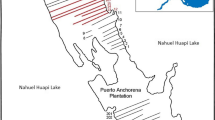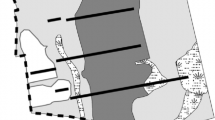Abstract
Microstegium vimineum (Japanese stiltgrass) is a non-native weed whose rapid invasion threatens native diversity and regeneration in forests. Using data from a 4 year experiment tracking new invasions in different habitats, we developed a spatial model of patch growth, using maximum likelihood techniques to estimate dispersal and population growth parameters. The patches expanded surprisingly slowly: in the final year, the majority of new seedlings were still within 1 m of the original patch. The influence of habitat was not as strong as anticipated, although patches created in roadside and wet meadow habitats tended to expand more rapidly and had greater reproductive ratios. The long-term projections of the patch growth model suggest much slower spread than has typically been observed for M. vimineum. The small scale of natural dispersal suggests that human-mediated dispersal, likely influenced by forest road management, is responsible for the rapid spread of this invasive species.




Similar content being viewed by others
References
Adams SN, Engelhardt KAM, Tessel SM (2006) Microstegium vimineum (Japanese Stiltgrass) impacts native diversity above threshold abundance. 91st Annual Meeting of the Ecological Society of America
Androw DA, Kareiva PM, Levin SA, Okubo A (1990) Spread of invading organisms. Landscape Ecol 4:177–188. doi:10.1007/BF00132860
Baiser B, Lockwood JL, La Puma D, Aronson MFJ (2008) A perfect storm: two ecosystem engineers interact to degrade deciduous forests of New Jersey. Biol Invasions 10:785–795. doi:10.1007/s10530-008-9247-9
Banasiak SE, Meiners SJ (2009) Long term dynamics of Rosa multiflora in a successional system. Biol Invasions 11:215–224. doi:10.1007/s10530-008-9226-1
Barden LS (1987) Invasion of Microstegium vimineum (Poaceae), an exotic, annual, shade-tolerant, C-4 grass, into a North-Carolina floodplain. Am Midl Nat 118:40–45. doi:10.2307/2425626
Bolker B (2008) Ecological models and data in R. Princeton University Press, Princeton
Braker WL (1981) Soil Survey of Centre County, Pennsylvania. In: United States Department of Agriculture SCS, in cooperation with the Pennsylvania State University College of Agriculture and the Pennsylvania Department of Environmental Resources, State Conservation Commission (ed)
Buckley YM, Brockerhoff E, Langer L, Ledgard N, North H, Rees M (2005) Slowing down a pine invasion despite uncertainty in demography and dispersal. J Appl Ecol 42:1020–1030. doi:10.1111/j.1365-2664.2005.01100.x
Burnham KP, Anderson DR (2004) Multimodel inference—understanding AIC and BIC in model selection. Sociol Methods Res 33:261–304. doi:10.1177/0049124104268644
Case TJ (2000) An illustrated guide to theoretical ecology. Oxford University Press, New York
Cheplick GP (2005) Biomass partitioning and reproductive allocation in the invasive, cleistogamous grass Microstegium vimineum: influence of the light environment. J Torrey Bot Soc 132:214–224. doi:10.3159/1095-5674(2005)132[214:BPARAI]2.0.CO;2
Cheplick GP (2007) Plasticity of chasmogamous and cleistogamous reproductive allocation in grasses. Aliso 23:286–294
Cheplick GP (2008) Growth trajectories and size-dependent reproduction in the highly invasive grass Microstegium vimineum. Biol Invasions 10:761–770. doi:10.1007/s10530-007-9170-5
Christen DC, Matlack GR (2009) The habitat and conduit functions of roads in the spread of three invasive plant species. Biol Invasions 11:453–465. doi:10.1007/s10530-008-9262-x
Cole PG, Weltzin JF (2004) Environmental correlates of the distribution and abundance of Microstegium vimineum, in east Tennessee. Southeast Nat 3:545–562. doi:10.1656/1528-7092(2004)003[0545:ECOTDA]2.0.CO;2
Cole PG, Weltzin JF (2005) Light limitation creates patchy distribution of an invasive grass in eastern deciduous forests. Biol Invasions 7:477–488. doi:10.1007/s10530-004-5171-9
Davis MA, Pelsor M (2001) Experimental support for a resource-based mechanistic model of invasibility. Ecol Lett 4:421–428. doi:10.1046/j.1461-0248.2001.00246.x
Davis MA, Grime JP, Thompson K (2000) Fluctuating resources in plant communities: a general theory of invasibility. J Ecol 88:528–534. doi:10.1046/j.1365-2745.2000.00473.x
Ehrenfeld JG, Kourtev P, Huang WZ (2001) Changes in soil functions following invasions of exotic understory plants in deciduous forests. Ecol Appl 11:1287–1300. doi:10.1890/1051-0761(2001)011[1287:CISFFI]2.0.CO;2
Ewel JJ (1986) Invasibility: lessons from South Florida. In: Mooney HA, Drake JA (eds) Ecology of biological invasions of North America and Hawaii. Springer, New York
Fairbrothers DE, Gray JR (1972) Microstegium vimineum (Trin) A-Camus (Gramineae) in United-States. Bull Torrey Bot Club 99:97
Flory SL, Rudgers JA, Clay K (2007) Experimental light treatments affect invasion success and the impact of Microstegium vimineum on the resident community. Nat Areas J 27:124–132
Heilbron DC (1994) Zero-altered and other regression-models for count data with added zeros. Biom J 36:531–547. doi:10.1002/bimj.4710360505
Horton JL, Neufeld HS (1998) Photosynthetic responses of Microstegium vimineum (Trin.) A. Camus, a shade-tolerant, C-4 grass, to variable light environments. Oecologia 114:11–19. doi:10.1007/s004420050414
Howard JL (2005) Microstegium vimineum in fire effects information system. US Department of Agriculture, Forest Service, Rocky Mountain Research Station, Fire Sciences Laboratory (http://www.fs.fed.us/database/feis/plants/graminoid/micvim/all.html.). Accessed Febr 2, 2007
Huebner C (2007) Strategic management of five deciduous forest invaders using Microstegium vimineum as a model species. Ohio Invasive Plants Research Conference Proceedings: 19–28
Humston R, Mortensen DA, Bjornstad ON (2005) Anthropogenic forcing on the spatial dynamics of an agricultural weed: the case of the common sunflower. J Appl Ecol 42:863–872. doi:10.1111/j.1365-2664.2005.01066.x
Hunt DM, Zaremba RE (1992) The northeastward spread of Microstegium vimineum (Poaceae) into New York and adjacent states. Rhodora 94:167–170
Jacquemyn H, Brys R, Neubert MG (2005) Fire increases invasive spread of Molinia caerulea mainly through changes in demographic parameters. Ecol Appl 15:2097–2108. doi:10.1890/04-1762
Jones BP, Mortensen DA (2004) Determining seed dispersal mechanisms for the large-scale invasion dynamics of Japanese stiltgrass (Microstegium vimineum). Abstracts. Weed Science Society of America, Kansas City, MO
Judge CA, Neal JC, Schear TH (2008) Japanese Stiltgrass (Microstegium vimineum) management for restoration of native plant communities. Invasive Plant Sci Manag 1:111–119. doi:10.1614/IPSM-07-011.1
Kourtev PS, Ehrenfeld JG, Huang WZ (1998) Effects of exotic plant species on soil properties in hardwood forests of New Jersey. Water Air Soil Pollut 105:493–501. doi:10.1023/A:1005037105499
Kourtev PS, Ehrenfeld JG, Haggblom M (2002) Exotic plant species alter the microbial community structure and function in the soil. Ecology 83:3152–3166
Liebhold AM, Halverson JA, Elmes GA (1992) Gypsy moth invasions in North America: a quantitative analysis. J Biogeogr 19:513–520. doi:10.2307/2845770
Lodge DM, Williams S, MacIsaac HJ, Hayes KR, Leung B, Reichard S, Mack RN, Moyle PB, Smith M, Andow DA, Carlton JT, McMichael A (2006) Biological invasions: recommendations for US policy and management. Ecol Appl 16:2035–2054. doi:10.1890/1051-0761(2006)016[2035:BIRFUP]2.0.CO;2
Lonsdale WM (1999) Global patterns of plant invasions and the concept of invasibility. Ecology 80:1522–1536
Lumley T (2008) Leaps: regression subset selection (using Fortran code by Alan Miller). Available http://cran.r-project.org/
Maheu-Giroux M, de Blois S (2007) Landscape ecology of Phragmites australis invasion in networks of linear wetlands. Landscape Ecol 22:285–301. doi:10.1007/s10980-006-9024-z
Marshall JM, Buckley DS (2008a) Effects of microsites created by selective harvesting on growth of Microstegium vimineum in a central hardwood forest. For Sci 54:534–542
Marshall JM, Buckley DS (2008b) Influence of litter removal and mineral soil disturbance on the spread of an invasive grass in a Central Hardwood forest. Biol Invasions 10:531–538. doi:10.1007/s10530-007-9149-2
Martin TG, Wintle BA, Rhodes JR, Kuhnert PM, Field SA, Low-Choy SJ, Tyre AJ, Possingham HP (2005) Zero tolerance ecology: improving ecological inference by modelling the source of zero observations. Ecol Lett 8:1235–1246. doi:10.1111/j.1461-0248.2005.00826.x
Marushia RG, Holt JS (2006) The effects of habitat on dispersal patterns of an invasive thistle, Cynara cardunculus. Biol Invasions 8:577–593. doi:10.1007/s10530-005-1601-6
Mehrhoff LJ (2000) Perennial Microstegium vimineum (Poaceae): an apparent misidentification? J Torrey Bot Soc 127:251–254. doi:10.2307/3088762
Mortensen DA, Rauschert ESJ, Nord AN, Jones BP (2009) The role of roads in plant invasions. Invasive Plant Sci Manag (in review)
Myers JH, Simberloff D, Kuris AM, Carey JR (2000) Eradication revisited: dealing with exotic species. Trends Ecol Evol 15:316–320. doi:10.1016/S0169-5347(00)01914-5
Okubo A (1980) Diffusion and ecological problems: mathematical models. Springer Verlag, Berlin
Oswalt CM, Clatterbuck WK, Oswalt SN, Houston AE, Schlarbaum SE (2004) First-year effects of Microstegium vimineum and early growing season herbivory on planted high-quality oak (Quercus spp.) seedlings in Tennessee. Proceedings of the 14th Central Hardwoods Forest Conference, pp 1–9
Oswalt CM, Oswalt SN, Clatterbuck WK (2007) Effects of Microstegium vimineum (Trin.) A. Camus on native woody species density and diversity in a productive mixed-hardwood forest in Tennessee. For Ecol Manag (in press)
Parendes LA, Jones JA (2000) Role of light availability and dispersal in exotic plant invasion along roads and streams in the H. J. Andrews Experimental Forest, Oregon. Conserv Biol 14:64–75. doi:10.1046/j.1523-1739.2000.99089.x
Peskin N (2005) Habitat suitability of Japanese stiltgrass Microstegium vimineum in an Appalacian forest. Master’s thesis, Intercollege Graduate Degree Program in Ecology, The Pennsylvania State University, University Park, 136 pp
Peskin N, Mortensen DA, Jones BP, Booher MR (2005) Grass-selective herbicides improve diversity of sites infested with Japanese Stiltgrass (Pennsylvania). Ecol Res 23:64–65
Petit JN, Hoddle MS, Grandgirard J, Roderick GK, Davies N (2008) Invasion dynamics of the glassy-winged sharpshooter Homalodisca vitripennis (Germar) (Hemiptera : Cicadellidae) in French Polynesia. Biol Invasions 10:955–967. doi:10.1007/s10530-007-9172-3
Rew LJ, Lehnhoff EA, Maxell BA (2008) Prioritizing non-indigenous species management using a survey, monitoring and modeling framework. Can J Plant Sci (Accepted for publication 12/2007)
Ribbens E, Silander JA, Pacala SW (1994) Seedling recruitment in forests—calibrating models to predict patterns of tree seedling dispersion. Ecology 75:1794–1806. doi:10.2307/1939638
Shadel WP, Molofsky J (2002) Habitat and population effects on the germination and early survival of the invasive weed, Lythrum salicaria L. (purple loosestrife). Biol Invasions 4:413–423. doi:10.1023/A:1023668918643
Sharov AA, Leonard D, Liebhold AM, Roberts EA, Dickerson W (2002) “Slow the Spread”: a national program to contain the gypsy moth. J For 100:30–35
Sutton JR, Stohlgren TJ, Beck KG (2007) Predicting yellow toadflax infestations in the Flat Tops Wilderness of Colorado. Biol Invasions 9:783–793. doi:10.1007/s10530-006-9075-8
R Development Core Team (2008) R: a language and environment for statistical computing. R Foundation for Statistical Computing, Vienna, Austria. ISBN 3-900051-07-0, URL http://www.R-project.org
The Pennsylvania State Climatologist (2007) (http://climate.met.psu.edu/data/state.php). Accessed March 8, 2007
The Pennsylvania State University Automated Weather Observation System (2007) The Pennsylvania State University Automated Weather Observation System at Rock Springs, PA. (http://www.meteo.psu.edu/~syrett/monthsum.htm). Accessed March 8, 2007
Trombulak SC, Frissell CA (2000) Review of ecological effects of roads on terrestrial and aquatic communities. Conserv Biol 14:18–30. doi:10.1046/j.1523-1739.2000.99084.x
Tu M (2000) Element Stewardship Abstract for Microstegium vimineum (http://tncweeds.ucdavis.edu/esadocs/documnts/micrvim.pdf). Accessed Febr 1, 2007, pp 1–8
USDA-NRCS (2007) The PLANTS database (http://plants.usda.gov.). Accessed 15 Jan 2007
Venables WN, Ripley BD (2002) Modern applied statistics with S. Springer, New York
Virginia Department of Conservation and Recreation NHP (2006) Species factsheet: Japanese stiltgrass (Microstegium vimineum) (http://www.dcr.virginia.gov/natural_heritage/invspfactsheets.shtml). Accessed Febr 2, 2007
Watkins RZ, Chen JQ, Pickens J, Brosofske KD (2003) Effects of forest roads on understory plants in a managed hardwood landscape. Conserv Biol 17:411–419. doi:10.1046/j.1523-1739.2003.01285.x
Weber E (1998) The dynamics of plant invasions: a case study of three exotic goldenrod species (Solidago L.) in Europe. J Biogeogr 25:147–154. doi:10.1046/j.1365-2699.1998.251119.x
Webster CR, Rock JH, Froese RE, Jenkins MA (2008) Drought–herbivory interaction disrupts competitive displacement of native plants by Microstegium vimineum, 10-year results. Oecologia 157:497–508. doi:10.1007/s00442-008-1085-z
Williams LD (1998) Factors affecting growth and reproduction in the invasive grass Microstegium vimineum. Masters, Biology, Appalachian State University
Winter K, Schmitt MR, Edwards GE (1982) Microstegium vimineum, a shade adapted C-4 grass. Plant Sci Lett 24:311–318. doi:10.1016/0304-4211(82)90027-X
Acknowledgments
We wish to thank Brian Jones, Matt Booher, Stephen Kinneer and Daniel Heggenstaller for assistance with fieldwork and Scott Harkcom for access to field sites. Three anonymous reviewers offered helpful comments. This work was partially supported by the National Research Initiative of the USDA-CSREES, grant number 2007-02917.
Author information
Authors and Affiliations
Corresponding author
Rights and permissions
About this article
Cite this article
Rauschert, E.S.J., Mortensen, D.A., Bjørnstad, O.N. et al. Slow spread of the aggressive invader, Microstegium vimineum (Japanese stiltgrass). Biol Invasions 12, 563–579 (2010). https://doi.org/10.1007/s10530-009-9463-y
Received:
Accepted:
Published:
Issue Date:
DOI: https://doi.org/10.1007/s10530-009-9463-y




